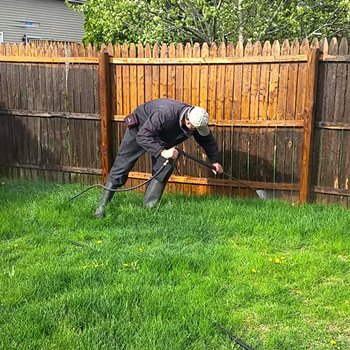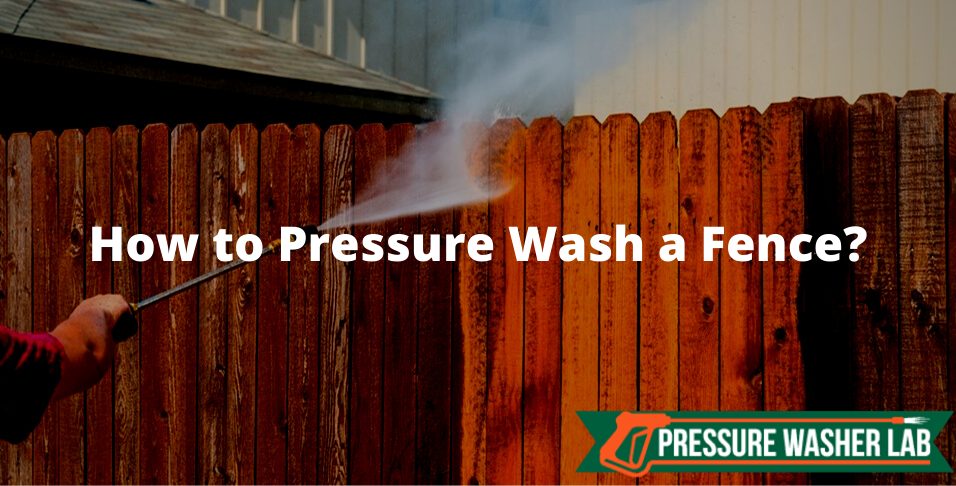Fence cleaning with a pressure washer can be safely performed by preparing the area, gathering the needed materials, attaching the accessories to the pressure washer, connecting the unit to a water supply, applying chemicals, rinsing the chemicals, and letting the fence dry for at least 24 hours.
These steps and the safety measures that need to be followed while pressure washing a fence are discussed in detail below.
Step 1. Prepare The Nearby Area
Power washing a fence requires the operator to prepare the area nearby in order to protect the vegetation and to avoid injury. Removing all objects in immediate proximity to the fence is recommended, as the operator could trip over them or the hoses and the cord could get entangled.
Before fence cleaning using a pressure washer, the plants nearby should be covered using a tarp regardless of whether chemicals are used or not. Some plants are sensitive and could get damaged when coming in contact with under-pressure water.
Step 2. Make Sure to Be provided with All Necessary Materials
The materials needed to pressure wash a fence are as follows:
- Pressure washer
- High-pressure hose
- Garden hose
- Pressure washer trigger gun
- Pressure washer nozzle tips
- Pressure washer wand
- Pressure washer detergent
- Pressure washer brush (optional)
- Safety goggles
Step 3. Connect the Pressure Washer Attachments
Before starting to pressure wash a fence make sure that the cleaning unit is safe to use by inspecting its essential components. Connect the high-pressure hose to the unit and, at the other end, connect the trigger gun. The use of a pressure washer wand is optional and depends on how high the fence is. After attaching the wand, connect the nozzle.
The nozzle recommended for pressure washing a fence is the green one, which has a spray pattern directed at 25 degrees. This nozzle type is gentle but powerful enough to clean a fence regardless of the material that it is made of.
Step 4. Connect the Pressure Washer to a Water Supply
 After attaching all the necessary pressure washer accessories, connect the garden hose to the pressure washer water inlet. The other end of the garden hose should be connected to a water faucet. Some battery-powered portable pressure washers are equipped with water tanks and do not need to be attached to a water source, they just need to be filled with clean water. Never add chemicals to the water tank of such a unit as it could damage the pressure washer.
After attaching all the necessary pressure washer accessories, connect the garden hose to the pressure washer water inlet. The other end of the garden hose should be connected to a water faucet. Some battery-powered portable pressure washers are equipped with water tanks and do not need to be attached to a water source, they just need to be filled with clean water. Never add chemicals to the water tank of such a unit as it could damage the pressure washer.
Step 5. Pressure Wash the Fence Using Clear Water
Make sure that the pressure washer can be adjusted to around 1500 PSI, or less if the fence is made of wood. Start by pressure washing chemical-free water onto the entire surface. The water that will come off the fence will form a small stream that will allow the detergents that will be applied afterward to drain without hurting the nearby vegetation.
Step 6. Change the Nozzle to a Soap Nozzle
The 25-degree pressure washer nozzle needs to be changed if the operator wants to apply chemicals. The only standard tip that can be used with chemicals is the black nozzle, also called the soap nozzle. Before performing the change, turn off the pressure washer. This step is required to avoid getting injured. Disconnect the nozzle and quick-connect the new one. Start the pressure washer for one cycle to verify if the nozzle tip is working properly and turn it off again.
Step 7. Supply the Pressure Washer with Chemicals
Pressure washing a fence using chemicals should be done only with detergents that are specially formulated for pressure washers. The type of soap should also be checked before use, as some of them could damage the wood. It is recommended to use a fully biodegradable pressure washer detergent to avoid damaging the soil and the plants in close proximity.
After checking that the detergent filter is on, add the cleaning solution to the detergent tank of the pressure washer. If the pressure washer soap needs to be diluted, do this before adding it to the power washer soap container.
Step 8. Pressure Wash the Fence Using Chemicals.
Turn on the pressure washer and spray the fence on separate smaller sections, starting from the bottom and going all the way to the top. This direction of work needs to be followed to avoid skipping a part that could cause marks to remain on the fence. Follow the indications on the pressure washer detergent label and leave the soap to soak in for as long as needed. This usually takes 5 to 15 minutes.
Highly dirty spots should be cleaned using a pressure washer rotating brush. Such a brush needs to replace the soap nozzle. Perform the switch by turning off the cleaning unit, disconnecting the nozzle, connecting the brush, and turning on the pressure washer.
Step 9. Rinse the Chemicals Off the Fence
Before rinsing the fence using a pressure washer, make sure to get all the detergent out of the unit by letting it work for a few cycles until the water stream coming out of it is detergent-free. Turn the power washer off and change the soap nozzle with the 25-degree one. Turn on the unit and rinse the fence from top to bottom, on sections.
Step 10. Let the Fence Dry for at Least 24 Hours Before Applying Any Treatments
Pressure washing a fence is often followed by treating the wood or painting it. If the wood is not fully dried, the treatments applied won’t penetrate well. The water will be trapped in the wood fibers and will cause the fence to rot from the inside out.
Fence Pressure Washing Safety Tips
- Keep a distance of 1,5 to 2 feet away from the fence to avoid destroying the material that it is made of.
- Never use a hot water pressure washer to power wash a fence.
- While pressure washing a fence, wear full shoes and long clothes to avoid getting injured. Neckties and letting long hair loose should be avoided because they could get entangled with the pressure washer wand.
- Wear safety goggles while pressure washing a fence.
- Children and pets should be kept away from the area that is being pressure washed.
- Avoid pointing the pressure washer to a direction other than the fence to avoid injuring the persons in close proximity.
- Never leave the power washer unattended because it might be hard to turn it off as the pressure coming out of the nozzle will make it move irregularly.

